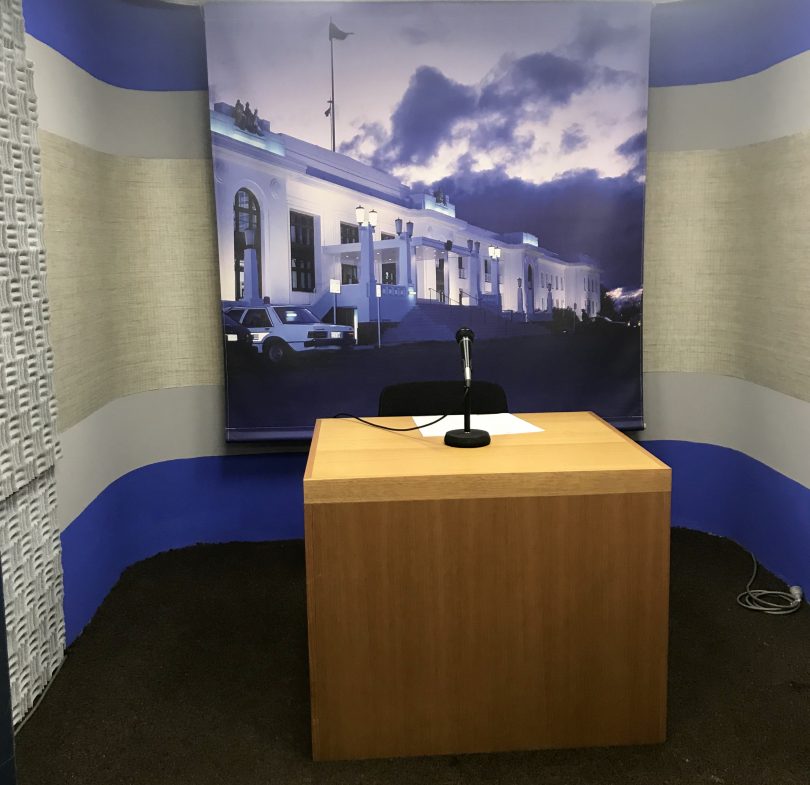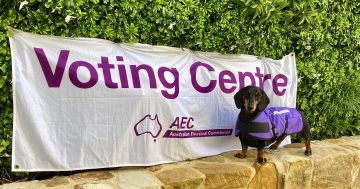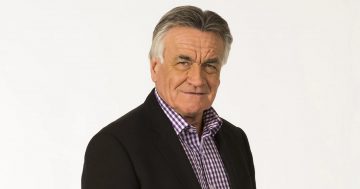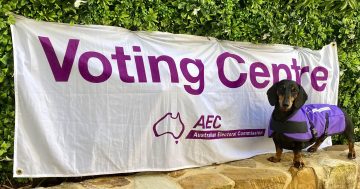
Journalists discuss the challenges of a contested media space at MOAD’s new exhibition on truth and free press. Photo: Supplied.
A free press is a fundamental cornerstone of democracy.
That’s a big claim but an eminently sustainable one. A society that lacks a free press cannot call truth to power. A society without a free press is condemned to propaganda. A society without a free press lacks the means for a vigorous exchange of dissenting views and a place to air them.
At a time when these values are being called into question around the world, the Museum of Australian Democracy at Old Parliament House has launched a new permanent exhibition, Truth, Power and A Free Press.
As MOAD director Daryl Karp points out, the swirling currents of global opposition have met with a perfect storm in the media industry, where old business models are rapidly collapsing as they struggle to cope with the onslaught of new technology.

MOAD director Daryl Karp with charts showing a continuous decline of trust in the media. Photo: Genevieve Jacobs.
“The Newseum in Washington talks very specifically about the importance of news in a democracy. Here at MOAD we have an interpretation of the press gallery but the actual importance of the free press and its place in democracy wasn’t being covered,” she says.
“So we began by asking what is press freedom, why is it important and what happens to democracies when you don’t have a free press?”
The thought process was bolstered by research looking at where Australia stands on a global basis with regard to press freedom, and the sense that the media itself is reeling as the media business model shatters.
Located in the old ABC Press Gallery and broadcasting space directly under the former House of Representatives chamber, MOAD aims to start a conversation with Australians about the significance of a free press in a healthy democracy and the challenges in finding a balance between the public’s right to know and the government’s responsibility to keep us safe.
Curated by Holly Williams, the exhibition traces the media’s evolution in Australia from a mid-19th-century printing press used by Sir Henry Parkes to the modern-day iPhone, examining how the means of production has shaped the way the news is told.

Truth, Power and a Free Press at MOAD incorporates multiple interactive elements. Photo: Supplied.
But critically, the show also looks at who tells the truth and how they do it. There is an immersive seven-foot tall audio-visual panel where you can interact with some of Australia’s most respected journalists including Chris Masters, Adele Ferguson, Jenny Brockie, Patrick Abboud and News Corp’s Annika Smethurst, subject of a police raid earlier this year seeking information about her sources.
Peter Greste’s letters smuggled to his family from an Egyptian prison are on display, as is documentation of the intimidation faced by investigative reporter Kate McClymont as she delved into the dirty world of NSW crime and corruption.
“For me, the journalist’s judgement becomes critical in this,” Daryl Karp says. “I’m a great believer that professional journalism is a cornerstone of a healthy democracy. There’s so much information now that we could never make sense of it all otherwise.
“The other element shaping this was the new phenomenon of truth decay. A consequence of technological change is that there’s an increasing disagreement on what bare objective facts actually are. There’s a disconnect between evidence and factual information, and an increase in opinion, a blurring of the lines.”
To that end, visitors are challenged on how readily they can identify truth, lies and spin. And it’s not especially easy to do so: could you tell instantly where the bias lies in a news story, or what’s false, true or satirical?
“The response from the public has been fantastic,” says Daryl. “People say they came to see the museum but spent their whole two hours in here. More than 1000 badges asking if you can tell the truth were collected in the first three weeks alone. We have never had this level of response from the public.”

The former ABC parliamentary broadcast booth has been incorporated into the MOAD free press exhibition. Photo: Genevieve Jacobs.
She believes that’s indicative of the deep concern about press freedom felt not only inside the industry but among politicians, public servants and ordinary citizens.
“Politicians feel that journalists are only after gotcha moments. Journalists feel they’re given talking points and channelled towards one person.
“The public service feels the capacity of journalists is diminished because there are no longer specialists with a deep understanding of their subject area. And the public hates the adversarial nature of how everything is presented.
“There are things we users of media and newspapers can actually do, like improve our media literacy, think about the source of our information and be aware that you could be sucked into an echo chamber. We want people to come away from MOAD feeling empowered, not scared”.
The Museum of Australian Democracy at Old Parliament House is open daily from 9:00 am to 5:00 pm.
Exhibitions are free after admission of $2 for adults and $1 children (free for children under 5 years old).





















